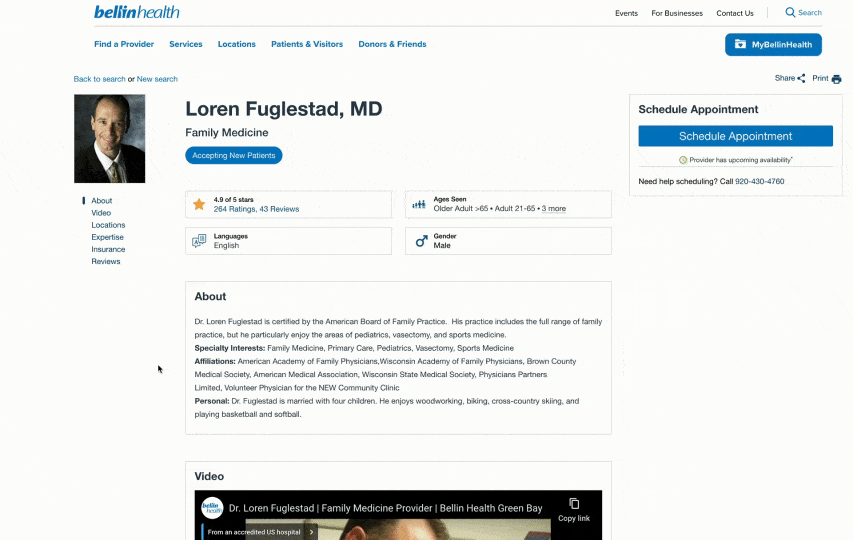
“Meet Dr. X.” Those physician bios are a core part of your healthcare marketing strategy. Done right, they’re a powerful tool for patient acquisition.
As a healthcare marketer, you want to craft a bio strategy that resonates with what patients actually want.
Which is … what, exactly?
At Aha Media Group, we work closely with providers to write outstanding, impactful profiles. So, we know what goes into a good bio. But we wanted hard data to back our approach. In the summer of 2024, we surveyed 534 people to figure out:
The results might surprise you. (They surprised us.)
Ready to dive in? Read on or download the report and recommendations summary. Don’t forget to share it with your team.
Hospital websites have quickly become the primary destination for getting info about providers. According to our 2024 study:
And many patients who start with Google or their insurance still end up on your site before making a decision.
Patients expect hospital websites to provide accurate, up-to-date information. Your Find-a-Doctor tool makes it easy for them to browse providers, check credentials, and feel confident in their choice.
This is a significant shift compared with a few years ago. Patients once relied on personal referrals and insurance sites, but today, they turn to hospital websites to find comprehensive details — bios, specialties, and reviews — all in one place.
Patients are turning to your website for provider info — so your provider section needs to be on point. Each physician profile has to be:
Our 2024 study shows that 92% of patients read a provider’s bio before booking an appointment. If your bios aren’t easy to find and compelling, you’re likely losing patients to competitors who’ve mastered the art.
Patients are looking for information in the bio that makes them feel comfortable and confident in booking an appointment. In 2018, only 76% of patients were reading bios. Today, it’s up nearly 17%. That’s not just a jump — it’s a clear shift in how patients choose their providers.
A patient is reading through the bio about your provider — what are they looking for? What are the magic words that will encourage them to make the appointment? Our 2024 survey shows that experience, insurance coverage, and online reviews are the top bio features driving patient decisions. Simply listing a provider’s name and medical school isn’t enough — patients need practical details that build trust and confidence.
55% of patients said that understanding a provider’s experience gives them the confidence to book an appointment. They care more about what a doctor has done and how they’ve helped others rather than where they earned their degree. Detailing specific areas of expertise, years in practice, and notable achievements is crucial for making patients feel they’re in capable hands.
Dr. X has over 30 years of experience in orthopedic surgery. She specializes in joint replacement procedures, including hip and knee replacements, using innovative, minimally invasive techniques. Her expertise has helped over 3,000 patients regain mobility and improve their quality of life.
44% of patients say insurance coverage is a make-or-break factor. Patients are unlikely to take the next step without knowing if their insurance is accepted. Ensure this information is front and center in every provider bio to eliminate guesswork.

44% of patients also rely on online reviews when deciding which provider to choose. Overall, 94% of patients said online reviews are important.
Positive reviews from real patients provide social proof and build credibility, making it easier for new patients to trust a provider. Up-to-date reviews included directly in bios can be a game-changer for boosting patient confidence.
In 2018, education and hospital affiliations had more influence. But by 2024, there’s a clear shift: Patients are focused on factors that help them feel secure in their decisions. This trend reflects a broader shift in healthcare, where patients want proof of competence and reassurance from others before committing.
Education is important, but it’s more of a baseline expectation now. 30% of patients say education is a factor, yet it doesn’t carry the same weight as experience, insurance coverage, or reviews. Patients assume every provider meets the basic qualifications, so they’re more focused on practical experience and validation from other patients.
Bottom line: Bottom of Form
Patients expect more than a list of credentials in today’s healthcare environment. They want to learn, at a glance:
For patients to take the next step and book an appointment, they need to feel a strong connection and trust with the provider. According to our 2024 survey, 3 key factors stand out as essential for building that trust:
A well-written bio is essential to this approach. It is part of the larger “story” of your providers, which should also include direct quotes, videos, linked blog posts, and patient testimonials. All of this content should convey the doctor’s care philosophy and values.
To create bios that convert, include what patients care about most:
See examples of physician bios that meet patients’ needs.
Provider bios are often the first impression patients get of your medical team. With 92% of people reading them before making an appointment, sloppy profiles aren’t an option. The problem? Bios are too often an afterthought, leading to confusing details, poor writing, and a frustrating experience for potential patients.
To avoid these missteps, we’ve pulled together a list of do’s and don’ts. Whether you’re onboarding new doctors, managing profiles across locations, or optimizing for SEO, these tips will help you create bios that inform, engage, and convert.
Do:
Don’t:
A good bio strategy isn’t a “set it and forget it” deal. Approach it with the same care you would for any other key piece of content. Follow these tips from our account team:
Don’t forget SEO cross-linking opportunities. Link to related blogs, patient stories, or even social media. This helps improve discoverability and patient engagement.
The bio-writing process shouldn’t be ad hoc or left to guesswork. A structured workflow ensures consistency and efficiency, especially when new providers join the organization. Here’s how to get it right:
Do: Standardize your provider bios with a template
Create a template for provider bios to keep things consistent across your organization. It’s not just about the format — it’s also about deciding exactly what information you need and how to present it:
If you’re using a third-party Find-a-Doc tool for profile management, know what fields are available from the beginning. Understanding the tool’s capabilities upfront will save you a lot of hassle later.
If the bio is for patients, it needs to be patient-friendly. Some providers might gear their bios toward their peers, particularly in academic settings. That’s great if you want to appeal to fellow academics — but to resonate with patients, the tone and content have to be accessible and focused on patient needs.
Merging locations or forming new partnerships can leave bios as an afterthought in the bigger transition plan. Don’t let that happen. Given that 92% of people look at bios before booking an appointment — and most of those searches happen on your site — prioritizing provider profiles is essential.
You’re putting a lot of work into a shiny new design, so don’t forget these crucial patient touchpoints.
Leaving the writing to providers can result in inconsistent styles, lengths, and quality. Not everyone is a great self-promoter or writer. We’ve seen less-than-stellar results when bios are published verbatim from a questionnaire.
Instead, ask the provider to fill out a questionnaire or send a CV, then hand it to a writer (with the template). This ensures a consistent tone, style, and structure. And, reminder, let your stakeholders know upfront that their words might be paraphrased or rewritten to fit the template.
Your website isn’t the only place where your providers’ profiles live. They’re likely on Google Business, Zocdoc, Healthgrades, and other platforms. While it might not be your job to manage all of these, you should at least be documenting them. Consistency across all channels is tough, but it starts with knowing what’s out there.
Download the summary of these findings along with a one-page how-to guide and share it with your department.
We’re on a mission to deliver clear healthcare content to your readers. As a healthcare marketer, you are constantly detangling the complex web of content challenges. We can help by creating strat... Read more
What Did You Learn? Episode 10Marketing teams can accomplish amazing things when they’re laser-focused and feel a sense of purpose. It also helps having leadership that gives ...read more
LinkedIn has more than 199 million U.S. users. Those users are your employees, colleagues, potential patients and future job candidates. If your healthcare company isn’t ...read more
What Did You Learn? Episode 2Working as content marketers and copywriters during the coronavirus pandemic taught us a lot. Hopefully, those lessons will carry over into our strategies ...read more
With at least 95 million new posts per day on Instagram alone, there’s a lot of competition on social media for hospitals (and everyone, really). Stopping the scroll has ...read more